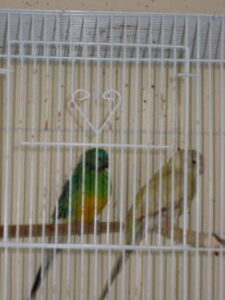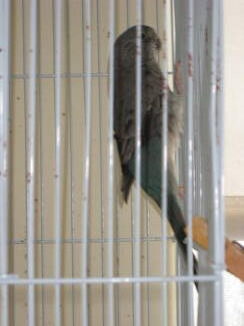Yesterday morning as I cleared my breakfast dishes from the table, I noticed a cat approaching along the back of the house. A very pretty cat that was not a stray or a neighbor’s pet. It had short tail and pointed ears along with spotted markings on its fur. As I reached for the camera which fortunately was there on the desk, the bobcat came right up to the kitchen door and looked in. I had to take the photos through the door. I tried to follow outside as it moved on to get a few other pictures, but the photo op did not last and the cat disappeared into the morning fog.
Critters
Crime Scene
 This morning I found the area around the two red rump pair cages looking like a crime scene. Blood was spattered all over the cage, the nearby walls and ceiling. Apparently something had caused the birds to have a night fright episode and they injured themselves flapping around in the dark despite the night lights. The bloodshed was an indirect result of something that happened a few weeks ago. Then, I just found lots of red rump wing feathers scattered around. The birds managed to drop all of their feathers on one or both wings. It is likely a small earthquake had disturbed them in the middle of the night. So now, instead of having one or two wing feathers growing back in as they should with a normal moult, they have a wingful or two of growing feathers. While they are growing in, these feathers have a blood supply and, if broken, can cause serious blood loss to the bird. The first aid recommendation for broken blood feathers is to pull out the feather in order to stop the bleeding.
This morning I found the area around the two red rump pair cages looking like a crime scene. Blood was spattered all over the cage, the nearby walls and ceiling. Apparently something had caused the birds to have a night fright episode and they injured themselves flapping around in the dark despite the night lights. The bloodshed was an indirect result of something that happened a few weeks ago. Then, I just found lots of red rump wing feathers scattered around. The birds managed to drop all of their feathers on one or both wings. It is likely a small earthquake had disturbed them in the middle of the night. So now, instead of having one or two wing feathers growing back in as they should with a normal moult, they have a wingful or two of growing feathers. While they are growing in, these feathers have a blood supply and, if broken, can cause serious blood loss to the bird. The first aid recommendation for broken blood feathers is to pull out the feather in order to stop the bleeding.
 I have no idea if the birds managed to do that to themselves or if the feathers just came out as a result of the panic in the cages. The evidence on the floor this morning shows that both of the hens lost at least three blood feathers last night, while the other red rumps lost one each. Meanwhile the other birds housed in adjacent cages showed no signs that they were bothered by the disturbance.
I have no idea if the birds managed to do that to themselves or if the feathers just came out as a result of the panic in the cages. The evidence on the floor this morning shows that both of the hens lost at least three blood feathers last night, while the other red rumps lost one each. Meanwhile the other birds housed in adjacent cages showed no signs that they were bothered by the disturbance.Pollinators
The honeybees are now including the garden in their daily routine. We went from none to a couple dozen workers buzzing around the flowers. No longer do I need to worry about zucchini blossoms getting pollinated. I am back to the usual problem with zucchini — what to do with so many of them. The other squash and pumpkins have also started showing fruit as a result of the bees’ efforts. We should have several nice pumpkins for Halloween decorations and Thanksgiving pies.
If I ever had any doubt about the bees acting as pollination agents, it would have been removed by a bee I saw a couple weeks ago near the just opening sunflowers. I had heard a buzzing and when I first caught a glimpse, I saw yellow and thought it might be a pesky yellow jacket. But then it landed on a sunflower and I discovered what the yellow color was — lots of pollen on the back of the honeybee.
the hungry caterpillar
A few days ago I brought in a handful of parsley from the garden. When I rinsed it off, I discovered that there were two uninvited caterpillars munching on the leaves. I shook them off outside and finished.
The next morning when I went out to check the garden, I remembered the caterpillars and decided I should check to see if there were more. If my garden was being invaded by a bunch of ravenous crawlers, the sooner I discovered the problem and protected my plants, the better. After looking around, I found two more. They were a lot more interesting looking that the usual suspects — black with orange spots. Were they bad guys I should feed to the birds or lizards or were these the juvenile form of a pretty moth or butterfly? I tried to identify them from an online reference but had no luck. Since the Master Gardeners have a volunteer in the agriculture commission office nearby on Wednesday, I decided to keep the caterpillars alive and eating until then and see if they could help with the identification.
This morning I was completely surprised by what I saw in the bug jar. They had changed their appearance overnight and now were black and green striped with yellow spots. And I was pretty sure I had seen something like that among the online photos. Sure enough, they matched the caterpillar of the Black Swallowtail butterfly . The information about the parsley family being the preferred host plant was perfect. I don’t recall ever seeing a swallowtail butterfly around, but apparently they decided that my parsley was a good place for their babies to hatch. Now that I know they exist, I will have to keep an eye out for the adult butterflies. Meanwhile the two captives have been returned to the garden.
Can of worms
Well, not exactly a can of worms. More like worms under the (black plastic nursery) cans.
Last week I decided that it was time to move the plants in nursery cans to weed around the fence. Much to my surprise, when I moved the large cans containing the citrus trees, I found evidence that there were earthworms at work. In all the years we have lived here, I have only seen a few worms. They seemed like such a rarity here that the last time it rained enough to flood the front walk area, I stopped and moved the one earthworm I found swimming in the puddle back to the dirt. The fact that I found maybe half a dozen or so worms under about the same number of pots, gives me hope that the land will come to life more rapidly than I was expecting as we start to planting the future orchard and vineyard.
I had a previous experience with rather “dead” soil years ago when we purchased our home in Saratoga. There was a metal shed and some areas of concrete in the back yard which we removed. I recall that one area was so bad that not even the weeds would grow in that spot for a few years. I was afraid that we might have a similar situation here. Perhaps all that is needed is a little bit of encouragement and some water.
